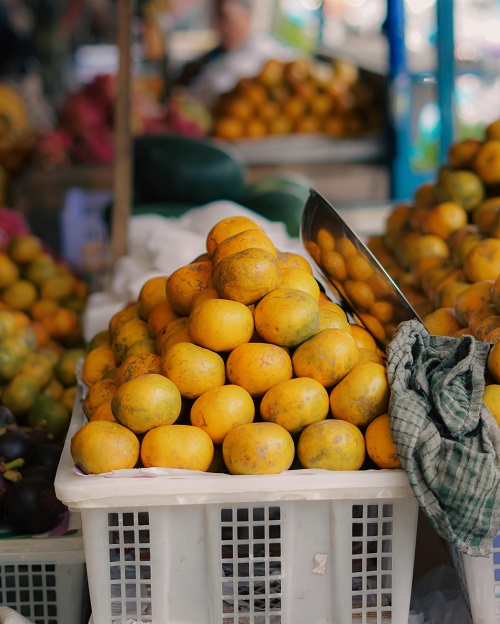Selling Oranges on Small Scale Business

Type: Retail/Small-Scale Agriculture.
Key Products for Sale:
- Fresh Oranges: Various varieties such as Valencia, Navel, and Blood oranges.
- Orange Juice: Freshly squeezed or packaged orange juice.
- Value-added Products: Orange marmalade, dried orange slices, and orange-flavored desserts.
Technology Considerations:
- Cold Storage: Investing in refrigeration units to preserve the freshness of oranges.
- Mobile Payment Systems: Accepting digital payments through mobile apps or card readers for convenient transactions.
- Online Presence: Utilizing social media platforms and websites for marketing and online sales.
- Inventory Management Software: Implementing software to track stock levels and monitor sales.
Market for the Products:
- Local Consumers: Individuals, families, and small businesses looking for fresh oranges and orange products.
- Hotels and Restaurants: Catering to the hospitality industry for use in cooking, beverages, and garnishes.
- Schools and Offices: Providing healthy snacks and beverages for students and employees.
- Farmers’ Markets: Selling directly to consumers at local farmers’ markets and community events.
Key Inputs into the Business:
- Fresh Oranges: Procuring oranges from local orchards or wholesale fruit markets.
- Packaging Materials: Containers, bags, or crates for storing and transporting oranges.
- Cold Storage Facilities: Renting or purchasing refrigerated storage units to maintain fruit freshness.
Marketing Materials: Signage, banners, and flyers for promoting products and attracting customers.
Transportation: Vehicles for transporting oranges from suppliers to retail locations or customers.
Product Preparation Process:
- Sourcing Oranges: Procuring fresh oranges from local orchards or wholesale suppliers.
- Sorting and Grading: Inspecting oranges for quality, size, and ripeness before packaging.
- Packaging: Packing oranges in containers or bags suitable for retail sale.
- Value-Added Processing (optional): Producing orange juice, marmalade, or dried slices for additional product offerings.
Marketing and Sales: Promoting products through various channels and selling to customers through retail outlets or online platforms.
Quality Considerations
Freshness: Ensuring oranges are fresh and free from bruises or defects.
Hygiene: Maintaining cleanliness in handling and storing oranges to prevent contamination.
Flavor: Offering oranges at peak ripeness for optimal taste and juiciness.
Customer Service: Providing friendly and helpful service to enhance the overall customer experience.
Cost of Investment:
Inventory: between KES 20,000 and KES 50,000 (initial purchase of oranges and packaging materials).
Cold Storage: between KES 50,000 and KES 100,000 (rental or purchase of refrigeration units).
Marketing: between KES 10,000 and KES 30,000 (for signage, banners, and promotional materials).
Transportation: between KES 30,000 and KES 50,000 (vehicle rental or fuel costs).
Miscellaneous Expenses: between KES 10,000 and KES 20,000 (for permits, licenses, and other operational costs).
Required Operational Infrastructure:
- Retail Outlet: Setting up a small retail space or stand for selling oranges.
- Cold Storage Facilities: Renting or leasing refrigeration units for storing oranges.
- Packaging Area: Designating space for sorting, grading, and packaging oranges.
- Marketing Channels: Establishing an online presence through social media or a website.
- Transportation: Arranging transportation for sourcing oranges and delivering products to customers.
Most Suitable or Viable Location of the Business:
Near Fruit Orchards: Proximity to orange orchards for sourcing fresh produce.
High-Traffic Areas: Locations with high foot traffic such as markets, malls, or tourist spots.
Residential Neighborhoods: Serving local communities with convenient access to fresh oranges.
Online Platforms: Utilizing e-commerce platforms to reach customers beyond local areas.
Potential Sources of Investment Capital:
- Personal Savings: Self-funding the business with personal savings or investments.
- Small Business Loans: Obtaining loans from banks or microfinance institutions for startup capital.
- Angel Investors: Seeking investment from individuals interested in supporting small-scale businesses.
- Crowdfunding: Raising funds through online crowdfunding platforms for business expansion or development.
Requirements for Effective Management:
- Product Knowledge: Understanding different orange varieties, quality standards, and customer preferences.
- Inventory Management: Efficiently managing stock levels, ordering, and replenishment to meet customer demand.
- Customer Service Skills: Providing excellent service, addressing customer inquiries, and resolving issues promptly.
- Marketing and Promotion: Developing marketing strategies to attract customers and increase sales.
- Financial Management: Monitoring expenses, tracking sales, and budgeting for profitability and growth.
Role of Mobile Phones and ICT in the Business:
- Online Sales: Utilizing mobile apps or websites for online ordering and delivery.
- Digital Marketing: Promoting products through social media platforms and online advertising.
- Inventory Management Apps: Using mobile apps for tracking inventory levels and stock movement.
- Customer Engagement: Communicating with customers through messaging apps or email for feedback and inquiries.
Statutory Regulations and Licenses:
- Business Registration: Obtaining necessary licenses and permits for operating a retail business.
- Business Registration: Registering your business with the appropriate government authority is typically the first step. This may involve registering as a sole proprietorship, partnership, or corporation, depending on your business structure.
- Food Safety Regulations: Compliance with food safety regulations is crucial when selling food products like oranges. This may include adhering to hygiene standards, proper handling practices, and maintaining a clean and sanitary environment.
- Health and Safety Regulations: Ensuring the safety of your products and workplace is essential. This may involve regular inspections to maintain health and safety standards, especially if you are processing oranges into juice or other value-added products.
- Permits and Licenses: Depending on your location and the scale of your operation, you may need specific permits or licenses. This could include a food handler’s permit, a business license, or permits for selling products at farmers’ markets or other public venues.
- Taxation and Compliance: Understanding and complying with tax regulations is crucial for any business. This may include obtaining a tax identification number, collecting and remitting sales tax, and filing annual tax returns.
- Environmental Regulations: If your business involves any activities that could impact the environment, such as waste disposal or water usage, you may need to comply with environmental regulations.
- Transport and Logistics: If you are involved in transporting oranges from farms to markets or processing facilities, you may need to adhere to regulations related to vehicle safety, transportation permits, and driver licensing.
Pricing:
- Fresh Oranges: Prices can vary based on factors such as variety, size, and seasonality. Offering competitive prices compared to other local vendors while ensuring a reasonable profit margin.
- Orange Juice: Pricing is based on the cost of production, including labor, packaging, and overhead expenses, with a markup to cover profit margins.
- Value-added Products: Setting prices based on production costs, market demand, and perceived value to consumers. Pricing competitively while considering profit margins and product differentiation.
Profitability:
With efficient operations and effective marketing, a small-scale orange-selling business can expect to generate annual profits ranging from KES 100,000 to KES 500,000 or more, depending on the scale of operation and market conditions. However, conducting thorough market research is essential, as managing costs effectively, and adapting to changing consumer preferences to maximize profitability.
Next Steps to Take:
- Expand Product Offerings: Introduce new varieties of oranges, value-added products, or complementary items such as other fruits or snacks to attract more customers and increase sales.
- Enhance Marketing Efforts: Invest in targeted marketing campaigns, including online advertising, social media promotion, and local events to raise brand awareness and attract new customers.
- Improve Customer Experience: Focus on providing exceptional customer service, offering product samples, and soliciting feedback to build customer loyalty and repeat business.
- Explore Distribution Channels: Consider partnering with local grocery stores, restaurants, or online platforms to reach a wider audience and expand distribution channels.
- Monitor Financial Performance: Regularly review financial statements, track sales metrics, and analyze profitability to identify areas for improvement and make informed business decisions.
- Invest in Business Growth: Reinvest profits into the business for expansion, upgrading equipment, or improving infrastructure to support long-term growth and sustainability.

